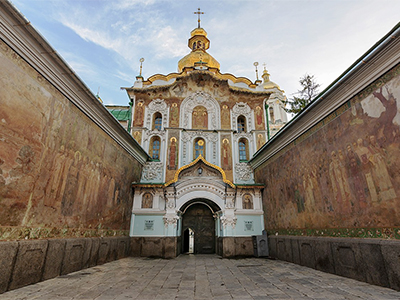 23.07.2018
Carpathian berries
23.07.2018
Carpathian berriesGathering raspberries in the Carpathians with a bear
Berries in the Carpathians contrary to mushrooms do not have to be searched, they are everywhere.
July showed itself surprisingly warm and the raspberry in the mountains ripened earlier. Our berry patch in Pasichna behind Nadvirna covered all the southern slopes of the mountain. As a rule we drove there a few times monthly – ripe raspberries bent down the branches to the earth. We set off a third time with rucksacks with daily food rations, buckets and a change of clothing in the case of rain (the weather in the Carpathians changes like a maiden). We were walking through the village and were asked by an older uncle, who was leading his cow to pasture in the fields. Are you going to the raspberries? Be careful, there is talk that a bear has been seen, he warned.
The weather in the Carpathians changes like a maiden.
We are city-inhabitants and reacted skeptically to his warnings. Most of us saw the animal in pictures in books or on television. The nearest we come to a bear is in a zoo. The attitude to bears is combined with a child’s love of plush toys and with stereotypes of young naturalists educated in the TV-program In the World of Animals. That bears are in fact sly and dangerous animals, though nobody. Even less believed us, that we could actually meet a bear.
A very real bear was feasting in the raspberry-cane
Arriving at the cherished place, we divided out and submerged in the thicket of the raspberry-cane. After a few hours of collecting the half-buckets with berries, I decided to rest. Nearby was a sympathetic trunk. I had barely sat on it, suddenly from somewhere very close; from somewhere behind my back I heard curious sounds. Someone was making his way through the raspberry-cane, breaking branches and champing loudly. I stood up to look and froze. Some five meters higher on the slope a very real bear was feasting in the raspberry-cane!
The animal stood erect on his back claws. With his front claws he shoveled raspberries together with leaves and twigs into his mouth, chewing loudly and growling slightly. Suddenly he heaved up his head and saw me. For a few seconds we looked at each other. I woke up from my shock and moved backwards. The beast opened his mouth and began to roar. In the next minute I was rushing down the slope and screaming at full voice.
Later the local forest ranger explained, as he gave us tea, that one must flee very quietly and that we were lucky. The bear was very young and was probably just as frightened like we were and he rashly left the raspberry-cane. If we would have had blundered upon an experienced pigeon-toed beast, we would have risked our life. The forest ranger showed us fresh scratches on tree-trunks – four deep unequal lines on a height of one and a half meters. So the bear was marking his territory. We would have no other alternative than to abandon the raspberry-cane.
For who have the berries ripened?
Climbing to highest region, one can return from the early autumn through the summer to a late spring.
Wandering in the Carpathians – is a rare possibility to gain unique experience of co-existing with nature. The mountains teach us many eternal truths. You convince yourself that when you take, you have to give and share. The raspberry with bears and roes, the blackberry and whortleberry with wild boars and foxes, squirrels and weasels, wild strawberry – with badgers and mice, frogs and snails, reptiles and birds.
Berry patches are the biggest source of nutrition for various forest populations from early spring to late autumn. The exceptionality of the berry season in the Carpathians preconditions an astounding combination of time zones and the division of the periods of the year. Depending on the height, berries ripen either all at the same time or over two-three weeks or are prolonged over a few months. Climbing to highest region, one can return from the early autumn through the summer to a late spring. To picking whortleberries at the feet of a mountain, to finding cowberries and wild strawberries on mild southern slopes, and to come upon crocuses, that flower alongside the rests of winter snow reserves.
In addition to berries, we offer to book a tour in the Carpathians pick up mushrooms.
In flatland before the mountains the berry season begins at the end of June and in the highest regions berries ripen only at the end of August. First appears the wild strawberry, which grows on the edge of forests, in fir forests, on meadows and along highland roads. The second half of July is the period of raspberry and wild whortleberry.
The blackberry appears in the Carpathians at the beginning of July, but in the highlands the season of its massive ripening is August. In September, begin the cranberry. Here and there in the highland tundra, in the higher part of Chorna Hora and the Horhany, on moss-covered slopes of Blyznytsya, Ihrovets, Petros and Sheshul grows the cranberry. Berries in the Carpathians contrary to mushrooms do not have to be searched, they are everywhere. Just go into the mountains and they will present them.
Curiosities about Carpathian berries
The leaves of the wild strawberry contain 5-7 times more vitamin C than the fruit of the berries. Decoctions of the grass of wild strawberries are for treating cases of gastritis, inflammations of the bowels, liver-illnesses and internal hemorrhages.
Two glasses of a wild raspberry secure the daily requirement of calcium of a five-year old child.
Wild berries are rich on iron salts. In 100 gr. of wild strawberry or cowberry there is sufficient iron for the daily needs of a women that is breastfeeding a child. Raspberries and whortleberries contain more iron than lemons, oranges and grapes.
A wild raspberry differs from its plantation counterpart with an eminent quantity on phosphor. A blackberry is rich on magnium and copper, that are needed for hematogenesis.
The productivity of berries is 10 times higher in forest parcels where the falling of logs took place, than in an untouched forest.
Etnomedicine recommends, that raw, boiled or wetted berries of cowberry are applied in cases of gastritis with low acidity, rheumatism, higher blood pressure and illnesses of the liver.
-
 27.02.2024
World of pysanka
Embark on a journey into the captivating world of Pysanka, the Ukrainian...
27.02.2024
World of pysanka
Embark on a journey into the captivating world of Pysanka, the Ukrainian...
-
 29.01.2024
Exploring the Treasures of Kyiv’s Lavra Monastery
In the heart of Kyiv lies the venerable Lavra Monastery, a testament...
29.01.2024
Exploring the Treasures of Kyiv’s Lavra Monastery
In the heart of Kyiv lies the venerable Lavra Monastery, a testament...
-
 13.01.2024
Kachanivka, Eden on Earth
Rich in history, it hosted renowned artists, notably poet Taras Shevchenko.
13.01.2024
Kachanivka, Eden on Earth
Rich in history, it hosted renowned artists, notably poet Taras Shevchenko.

